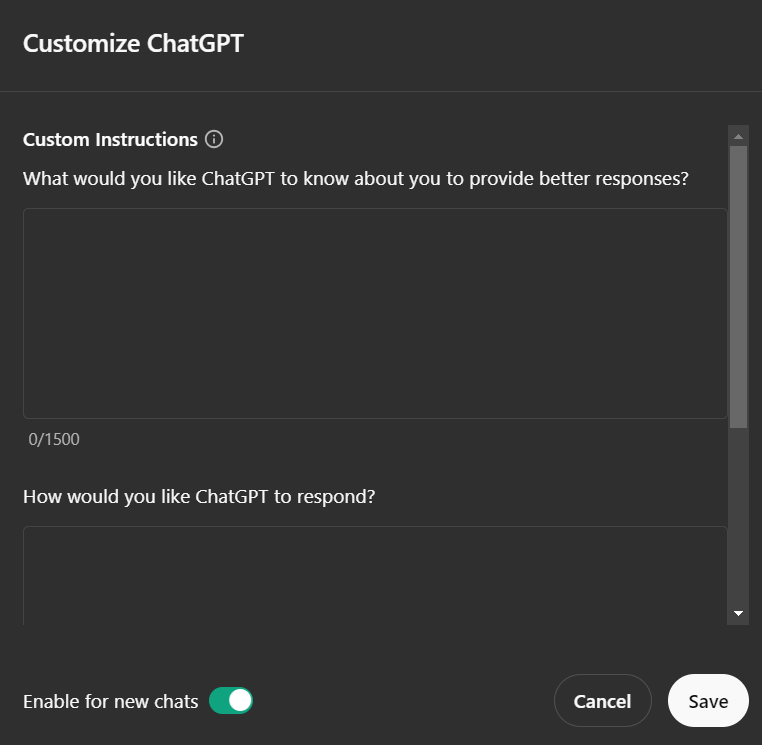Table of Contents
This article introduces ChatGPT’s Custom Instructions as a transformative tool for content creators. By tailoring interactions based on specific guidelines, marketers can ensure their brand’s voice remains consistent while effectively targeting diverse audience segments.
What are custom instructions?
ChatGPT’s custom instructions allow users to provide specific guidelines or parameters that shape how the AI generates responses. This feature is particularly useful for tailoring the AI’s output to better align with specific goals, preferences, or requirements.
For example, in digital marketing, you might use custom instructions to ensure that ChatGPT maintains a certain tone, adheres to brand guidelines, incorporates specific keywords for SEO, or handles customer queries in a way that aligns with your company’s communication style. This customization can greatly enhance the relevance and effectiveness of the AI-generated content and interactions, making it a valuable tool for engaging with audiences and managing tasks.
In digital marketing, custom instructions can be particularly valuable in several ways:
- Brand Voice Consistency: Marketers can ensure that all generated content aligns with the brand’s voice and tone by setting custom instructions that direct the AI to emulate these characteristics. This consistency is crucial for brand recognition and customer trust.
- Content Creation: Custom instructions can guide the AI in generating marketing content such as blog posts, social media updates, and promotional emails that adhere to specific guidelines, such as using certain keywords or maintaining a particular sentiment.
- Customer Interaction: AI can be customized to handle customer queries in a manner that reflects the brand’s values and communication style, enhancing customer service interactions through chatbots or virtual assistants.
- Compliance and Sensitivity: By setting custom instructions, marketers can ensure that the content created by the AI avoids regulatory red flags and is sensitive to cultural and social contexts, reducing the risk of reputational damage.
- Targeted Marketing: Custom instructions can help tailor content and responses based on different audience segments, improving engagement through personalized and relevant communication.
Using custom instructions effectively requires a clear understanding of your brand’s goals and audience preferences, enabling you to leverage AI in creating and managing content that resonates with your target market.
You can find Custom Instructions in ChatGPT, by clicking on your avatar:

And here you will see two sections: “What would you like ChatGPT to know about you to provide better responses?” and “How would you like ChatGPT to respond?”

Some practical examples for digital marketing experts

What would you like ChatGPT to know about you to provide better responses?
The section “What would you like ChatGPT to know about you to provide better responses?” is great for a digital marketing expert to really fine-tune the assistance they receive. Here are some example entries that could be beneficial for leveraging ChatGPT’s capabilities effectively:
- Industry Focus: “I specialize in digital marketing for healthcare and wellness brands. Tailor your advice and examples to fit regulations and trends in these sectors.”.
- Content Preferences: “I often need to create SEO-optimized blog posts and engaging social media content. Provide examples and suggestions that help improve readability and engagement.”.
- Tool Familiarity: “I regularly use tools like Google Analytics, SEMrush, and HubSpot. When discussing analytics or campaigns, integrate references or strategies involving these tools.”.
- Campaign Goals: “My primary marketing goals are to increase brand awareness and lead generation. Focus your responses to support these objectives, particularly through organic search and paid media.”.
- Competitive Landscape: “I’m located in a highly competitive market for emerging technologies. I need insights into current trends and competitive strategies in this niche.”.
- Skill Enhancement: “I am keen on improving my skills in video marketing and AI-driven content personalization. Offer detailed advice and up-to-date techniques in these areas.”.
- Team Dynamics: “I manage a small, dynamic marketing team. Provide tips on collaboration, project management, and efficiency tools that could help streamline our processes.”.
- Reporting Needs: “I frequently need to report campaign performance to stakeholders. Suggest formats and key metrics that effectively communicate success and areas for improvement.”.
By providing ChatGPT with specific information about your professional background, tools, and goals, you can get more targeted and practical advice that aligns directly with your daily needs and long-term objectives. This customization not only saves time but also enhances the relevance and applicability of the information you receive, making your interactions with AI more efficient and impactful.
How would you like ChatGPT to respond?
For a digital marketing expert, tailoring how ChatGPT responds can streamline the interaction and ensure the responses are immediately useful. Here are several example instructions you might include in the “How would you like ChatGPT to respond?” section to optimize your experience:
- Conciseness: “Please keep your responses concise and to the point, ideally no more than three sentences per explanation unless detailed analysis is requested.”.
- Actionable Tips: “Provide actionable tips and step-by-step guidance when discussing strategies or tools, so I can easily implement them in my campaigns.”.
- Data-Driven Insights: “Include data-driven insights and statistics to support your recommendations, and cite sources where possible to add credibility.”.
- Visuals and Examples: “Include examples of successful digital marketing campaigns, and when discussing complex concepts, provide diagrams or infographics to illustrate points clearly.”.
- Trend Updates: “Highlight the latest trends in digital marketing in your responses. I’m particularly interested in emerging technologies and innovative campaign strategies.”.
- Tools and Software Recommendations: “Suggest digital marketing tools and software, providing a brief comparison of features and costs. Highlight any free tools or trials available.”.
- SEO Best Practices: “When discussing content creation, include SEO best practices and how to optimize various types of content, from videos to blog posts.”.
- Risk Mitigation: “Discuss potential risks or common pitfalls in digital marketing strategies and offer advice on how to avoid or mitigate these issues.”.
- Customization for Audience: “Customize responses to reflect strategies that are most effective for engaging a tech-savvy audience interested in digital marketing.”.
- Language and Tone: “Use a professional yet engaging tone that blends well with the sophisticated nature of digital marketing topics.”.
10 Common Mistakes to Avoid with Custom Instructions in ChatGPT

Using ChatGPT’s custom instructions can be a game-changer for personalized responses in marketing, customer service, and content creation. However, there are some common mistakes users make when setting up these instructions. Here’s how to avoid them to get the best results from the AI:
- Vague or Thin Instructions: Many users provide overly broad or unclear instructions, which can lead to generic or irrelevant responses. Instead, your custom instructions should be as specific and detailed as possible. For example, if you’re asking ChatGPT to write a blog post, provide information about the tone, target audience, and key points you want covered.
- Overloading with Complex Language: While it’s tempting to over-explain or use technical jargon, this can confuse the AI. Keep your instructions concise and clear. Simple, direct language yields better outcomes. If you need ChatGPT to perform a complex task, break it down into smaller, manageable parts.
- Not Testing or Iterating: Custom instructions often require experimentation. Many users set up instructions once and expect them to work perfectly. It’s essential to review the outputs and adjust your instructions until you get the desired results. Be prepared to iterate.
- Failing to Address Edge Cases: Sometimes, custom instructions don’t account for exceptions or edge cases. For example, if you’re setting up ChatGPT for customer support, consider providing specific guidance on how to handle unusual or tricky queries.
- Expecting Perfection from One Version: ChatGPT can provide excellent results, but it’s not perfect. Users often make the mistake of not fact-checking the AI’s responses, especially in areas where accuracy is critical, such as technical or legal matters. Always review the content before using it.
- Over-Reliance on One Instruction Set: Custom instructions are meant to guide the AI for specific tasks. Some users, however, rely on a single set of instructions for multiple contexts. It’s essential to tailor your instructions for different scenarios—whether it’s for writing, marketing, or customer support.
- Ignoring Model Upgrades: Sticking to older models instead of upgrading to more advanced versions can limit the performance of your custom instructions. At the moment, GPT-4 provides better accuracy and handling of complex prompts, so it’s worth considering if you’re using ChatGPT for business-critical tasks.
- Not Reviewing Output for Tone Consistency: One common issue is when the output doesn’t match the desired tone. This happens when instructions are not specific enough about the tone or style of responses. Make sure to clearly define whether you want a formal, casual, or humorous tone.
- Overcomplicating with Too Many Roles: Users sometimes try to set up ChatGPT with multiple roles (e.g., a customer service agent and a social media manager), which can confuse the AI. Stick to one clear role for each use case, and adjust your instructions accordingly.
- Inconsistent Feedback: If you don’t get the desired output, instead of restarting, it’s better to give feedback within the same conversation to guide ChatGPT toward the right result. Many users quit too soon without letting the AI “learn” from their input.
In conclusion, by tailoring the AI with ChatGPT’s Custom Instructions to better understand your brand’s unique voice and objectives, you’re not just automating tasks; you’re enhancing every customer interaction, driving engagement, and ultimately, boosting your bottom line. As the digital marketing landscape continues to evolve, those who leverage these advanced tools will stand out, leading the way in delivering truly personalized experiences at scale. Don’t just follow the future of AI in marketing—shape it.

